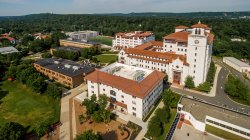Stacy Salley-Proctor Describes Reggio Emilia Education for U.S. News
Lead Infant and Early Childhood Consultation Specialist for CAECMH Shares Thoughts on the Educational Style
Posted in: College News and Events

Stacy Salley-Proctor, Lead Infant and Early Childhood Consultation Specialist at the Center for Autism and Early Childhood Mental Health, described Reggio Emilia Education for a recent article in U.S. News.
Reggio Emilia education is an Italian form of preschool that has gained popularity in the United States. Educational psychologist Jerome Bruner observed the school style on his first trip to Reggio Emilia, Italy, where the preschools were launched after World War II and still operate today. Many schools in the U.S. take inspiration from Reggio Emilia, offering a student-centered environment that encourages children to learn through experience, express themselves and play a role in directing their education.
“Young children are encouraged to explore their environment and express themselves through multiple paths and all their ‘languages,’” Bruner wrote. “Children experiment … in using spoken language, gestures, drawing, painting, building, clay and wire sculpture, shadow play, collage, dramatic play, music and emerging writing, to name but a few.”
Salley-Proctor noted the exploration and expression integral to Reggio Emilia are important to help children discover themselves.“Since everyone learns differently, Reggio Emilia’s varied ways of teaching open the door for children to discover how they best understand and learn,” she wrote in an email. Bruner, who died in 2016, captured a scene of Reggio Emilia in action in his writing. “One day, in a Reggio municipal nursery school, I was observing some 4-year-old children and a teacher who were projecting shadows and making efforts to draw them,” he wrote. “The (children’s) concentration was absolute, but even more surprising was the freedom of exchange in expressing their imaginative ideas about what was making the shadows so odd, why they got smaller and swelled up … (the teacher) behaved as respectfully as if she had been dealing with Nobel Prize winners.”
